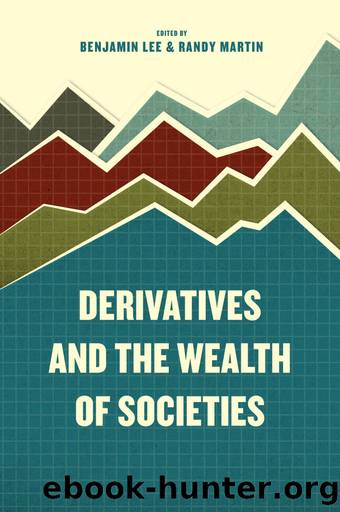Derivatives and the Wealth of Societies by Benjamin Lee & Randy Martin & Randy Martin

Author:Benjamin Lee & Randy Martin & Randy Martin [Benjamin Lee and Randy Martin]
Language: eng
Format: epub
ISBN: 978--0-226-39297--4
Publisher: University of Chicago Press
Published: 2016-11-02T00:00:00+00:00
By the 1990s the ability to manufacture fully hedged, dollar-denominated assets in which capital could be accumulated allowed for a world economy in which persistent trade deficits and trade surpluses could simply be financed rather than eliminated. This is the phenomenon that we commonly refer to as âglobalizationâ when we want to stress its effect on the shifting spatial location of production. It is alsoâand just as importantlyâa regime of financialization, which is what we call it when we want to stress its effect in creating vehicles of capital accumulation that are not necessarily investments in expanded production.
The essential point is that the globalization of production required globalization of financial marketsâfree flow of capital in a way that can offset trade deficits. This lifting of capital controls (the state-imposed requirements for domestic reinvestment that monetary economists call âfinancial repressionâ) was connected to increased repression of the âinflationaryâ political pressures for high public spending characteristic of the welfare state during the late Bretton Woods era. In addition to keeping inflation low, the new job of the central banks was to supply enough money to keep liquidity high in the market for safe collateral in which asset value can be stored (Blinder 1998). Beginning in the 1980s, growth in the dollar value of markets in purely financial assets had been effectively decoupled from growth in the dollar value of GDP, and by the 1990s it would exceed the rate of GDP growth by an ever-growing margin.
I indicated earlier that this new world of liquidity in both energy and finance changed the use and meaning of money, and having introduced the concept of financialization, I am in a better position to say why. Standard texts in economics say that money is a measure of value, a store of value, and a medium of exchange. What finance textbooks add is that in capital asset markets the particularity of money is also a measure of the gap between the liquidity (or price) of an asset and its liquidation value (the monetizability of required collateral)âa gap that can be continuously measured by engaging in a market for options that sets a price on the risk of default.
Put crudely, liquidity is the property that financial assets have when they can be priced without being turned into money by stripping off all or some of this credit risk through an options market. An assetâs liquidation value is the cash that a lender could get out of it by selling the collateral in the event of nonperformance on the expected revenue stream. The expected liquidation value of an asset, for example in bankruptcy, is generally less than its mark-to-market price as a performing asset, which is why secured lenders almost always require borrowers to post a capital cushion, or take a âhaircut,â as the margin on pledged collateral that may have to be sold into a falling market (Gorton and Metrick 2010a; Kaminska 2011b). When liquidations become widespread, the value of collateral collapses much faster than the value of the debt that it is liquidated to repay (Minsky 1986).
Download
This site does not store any files on its server. We only index and link to content provided by other sites. Please contact the content providers to delete copyright contents if any and email us, we'll remove relevant links or contents immediately.
| Analysis & Strategy | Bonds |
| Commodities | Derivatives |
| Futures | Introduction |
| Mutual Funds | Online Trading |
| Options | Portfolio Management |
| Real Estate | Stocks |
Pioneering Portfolio Management by David F. Swensen(5617)
Rich Dad Poor Dad by Robert T. Kiyosaki(5171)
How To Win Friends and Influence People by Dale Carnegie(3784)
The Money Culture by Michael Lewis(3293)
The Dhandho Investor by Mohnish Pabrai(3178)
The Wisdom of Finance by Mihir Desai(3089)
Liar's Poker by Michael Lewis(2822)
The Intelligent Investor by Benjamin Graham Jason Zweig(2603)
The ONE Thing by Gary Keller(2533)
Mastering Bitcoin: Programming the Open Blockchain by Andreas M. Antonopoulos(2523)
Investing For Dummies by Eric Tyson(2479)
How to Day Trade for a Living: Tools, Tactics, Money Management, Discipline and Trading Psychology by Andrew Aziz(2456)
How to Win Friends and Influence People by Dale Carnegie(2446)
Rich Dad Poor Dad: What The Rich Teach Their Kids About Money - That The Poor And Middle Class Do Not! by Robert T. Kiyosaki(2442)
Fooled by Randomness: The Hidden Role of Chance in Life and in the Markets by Nassim Nicholas Taleb(2423)
Zero Hour by Harry S. Dent Jr. & Andrew Pancholi(2254)
Market Wizards by Jack D. Schwager(2172)
Rich Dad's Guide to Investing by Robert T. Kiyosaki(2119)
How to Pay Zero Taxes, 2018 by Jeff A. Schnepper(2107)
